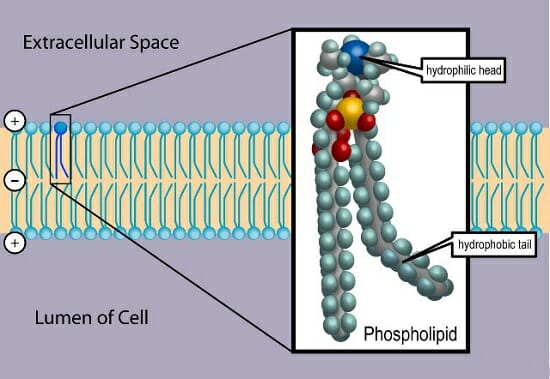What Characteristics Best Describe the Tail of a Phospholipid Molecule
Like any other lipid phospholipids are also amphipathic molecules that is they have a hydrophilic polar end often known as the polar head and an apolar end called the apolar tail which has hydrophobic characteristics. The tail of phosholipids consist of fatty acids These fatty acids can be saturated fatty acids or unsaturated fatty acids.

Components And Structure Biology 2e
Hydrophobic As a researcher in a protein lab you analyze two different proteins for their shape and the amino acids they contain.
. Within the plane of their own monolayer. However it must for a phospholipid to have two fatty acids attached to alcohol via an ester bond and a phosphate group attached to the same alcohol molecule via a phosphodiester bond. The polar phosphate end is hydrophilic.
Hydrophobic Which term correctly describes the entire phospholipid molecule. According to its definition the answer is. The head and the tail.
A phospholipid is made up of two fatty acid tails and a phosphate group head. The second group the hydrophobic tail consists of two fatty acid chains. A phospholipid consists of two basic parts.
Which characteristic describes the tails of phospholipids. Neutral charge nonpolar and hydrophobic. All cells are surrounded by the cell membranes and this characteristic best portrayed by the Fluid Mosaic ModelAccording to this model which was postulated by Singer and Nicolson during the 1970s plasma membranes are composed of lipids proteins and carbohydrates that are arranged in a mosaic-like manner.
However the fatty acids impart the hydrophobic characteristics to these compounds. Hydrophobic interactions between the nonpolar fatty acid tails help them avoid interacting with water. These groups are polar and are attracted to water.
Phospholipids consist of a glycerol molecule two fatty acids and a phosphate group that is modified by an alcohol. The hydrophobic tails each containing either a saturated or an unsaturated fatty acid are long hydrocarbon chains. The fatty acid chains are the uncharged nonpolar tails which are hydrophobic.
The head is the phosphate group and the tails are the two fatty acids. Fatty acids are long chains that are mostly made up of hydrogen and. The phospholipid is shaped like a thumbtack with two tails protruding from the head.
Some species use three fatty acid chains but two is most common. When many phospholipids line up they form a double layer that is characteristic of all cell membranes. Which characteristics best describe the side chains in the part of the protein in contact with the phospholipid tails of the membrane.
Which statement best describes the structure of a phospholipid. Unsaturated fatty acids have double bond or. The presence of phosphate group in phospholipids makes them polar.
Each phospholipid is made up of two fatty acids a phosphate group and a glycerol molecule. Since the tails are hydrophobic they face the inside away from the water and meet in the inner. Water repels the nonpolar tails of the phospholipid molecule causing the nonpolar tails to pack closely together and form two layers facing each other not the water so that none of the tails comes in.
The phosphate group is the negatively-charged polar head which is hydrophilic. The hydrophilic head consists of a glycerol molecule bound to a phosphate group. The heads are closer to the inner and.
Molecule that is attracted to water water-loving Hydrophilic Molecule that contains both a hydrophobic and a hydrophilic end Amphipathic Amphipathic lipid made of glycerol two fatty acid tails and a phosphate group Phospholipid A biological membrane involving two layers of phospholipids with their tails pointing inward Phospholipid bilayer. The characteristics that best describe the tail of a phospholipid molecule are a. Amphipathic amphipathic having both a hydrophilic region and a hydrophobic region In a lipid bilayer where do lipids rapidly diffuse.
The nonpolar tails are hydrophobic. It is a diglyceride - a glycerol with two fatty acid tails What kind of bond or attraction holds the two halves of the phospholipid bilayer together. This characteristic is vital to the structure of a plasma membrane because in water phospholipids tend to become arranged with their hydrophobic tails facing each other and their hydrophilic heads facing out.

How Can The Structure Of A Phospholipid Molecule Be Described Quora

Phospholipids Introduction To Chemistry

Phospholipid Definition Structure Function Biology Dictionary
14 3 Phospholipids In Cell Membranes Chemistry Libretexts
How Can The Structure Of A Phospholipid Molecule Be Described Quora



No comments for "What Characteristics Best Describe the Tail of a Phospholipid Molecule"
Post a Comment